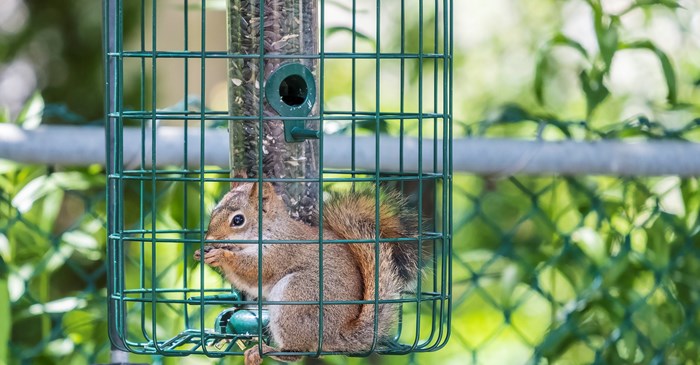How many “tricks” have you tried to keep the squirrels from your bird feeders? Most of us have tested one or two methods like suspending a feeder from wire, using a pole with a baffle or buying a feeder advertised as “squirrel proof.” In order to choose a solution that will really work, one needs to know as much as possible about the habits and especially the acrobatic skills of this favorite of the backyard buffoons—the squirrel.
Squirrels can jump 5 to 10 feet vertically and 8 to 10 feet between objects. Its big, bushy tail is large enough to serve as an umbrella or shade and although many think they are cute and furry, they are actually members of the rodent family, a group with an unpleasant reputation. Their front teeth never stop growing so they can gnaw on things throughout their lifetimes doing wholesale damage without wearing down a tooth. They can live in cities or in the country, in tree cavities or in nests made of leaves and twigs.
Squirrels eat nuts and seeds, insects and even small animals. Watch out! They’ve even been known to eat baby birds. There are flying squirrels that don’t fly (they leap and glide), fox squirrels, tassel-eared squirrels, gray squirrels and red squirrels. Wild squirrels live about four years and their home territory can cover a range of 100 acres.
What to do...to "squirrel-proof"
Although “squirrel-proof” can be misleading because of the very unpredictable and surprising nature of the squirrel, here are some tips and techniques that have worked successfully to prevent squirrels from raiding your feeders.
- Install baffles or guards above or below bird feeders to keep squirrels from getting to the perch, portal and food of the feeder.
- Trim tree limbs and branches 6 to 8 feet from buildings and feeders to keep squirrels from leaping onto feeders and roofs.
- Consider providing an alternative food source, like Lyric Wildlife Food or hang ears of corn away from feeders and bird habitats.
- Near orchards or high-value crops, farmers actually remove trees or woods to block squirrel traffic.
- Ro-pel and Capsaicin are taste repellents. You can apply them to seeds, bulbs, and flowers; trees and shrubs; poles and fences; siding and outdoor furniture.
- You can purchase “squirrel-proof” feeders, but beware—these creatures are inventive and some can outsmart even the most ingenious mechanisms. Baffles work sometimes, although the placement, size and positioning of the baffle will often determine its effectiveness.
The best “squirrel proof” feeders have an adjustable weight-activated or counter-weighted perch that shuts off the seed flow when a squirrel sits on the perch or when a heavy bird tries to feed. This feeder can be tree or pole mounted.
Squirrels can’t climb the smooth pole to reach it. Other effective squirrel-proof feeders are surrounded by a wire cage or mesh that only allows small birds to access the seed.
A domed roof feeder can also be an effective deterrent. Squirrels simply slide off when they try to leap on or hang on to the dome exterior.
A feeder with a battery operated “sting,” that affects squirrels but not birds, is a great way to teach that unwelcome squirrel a lesson!
